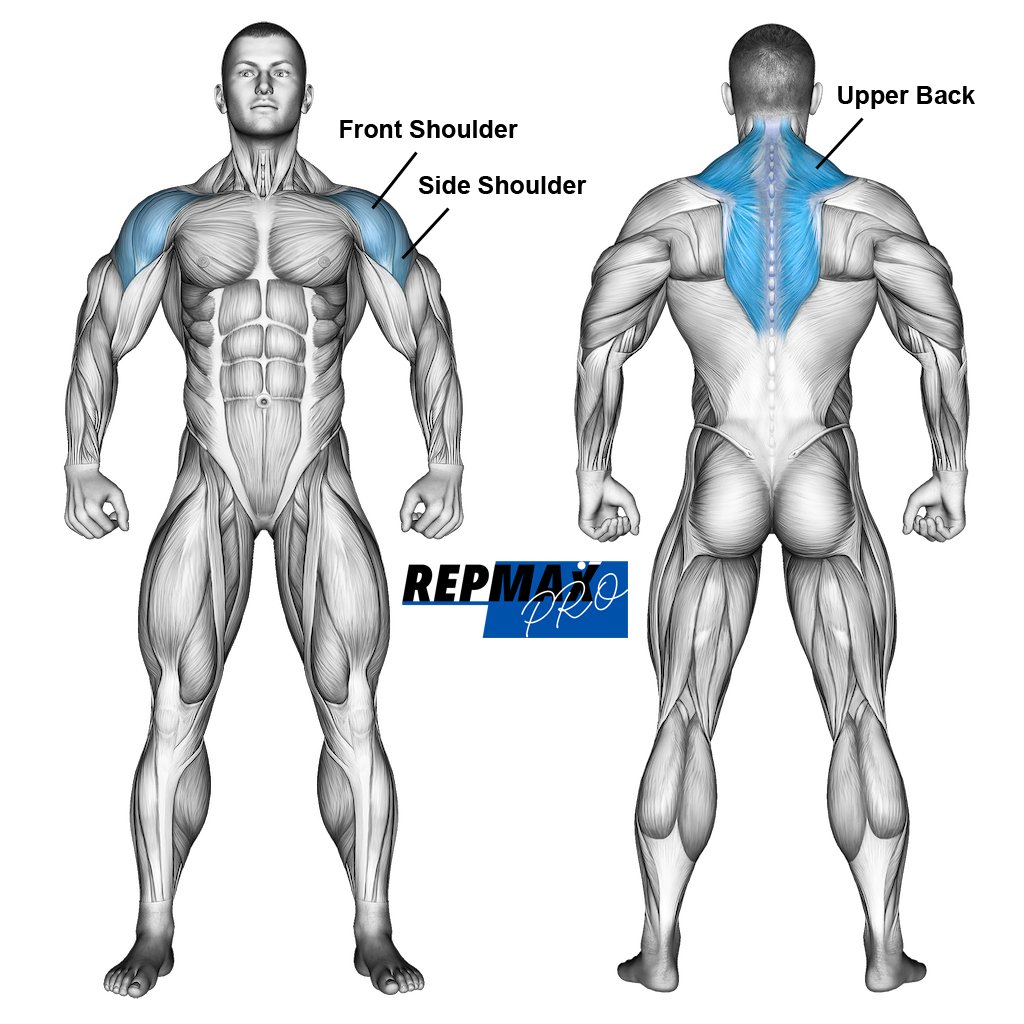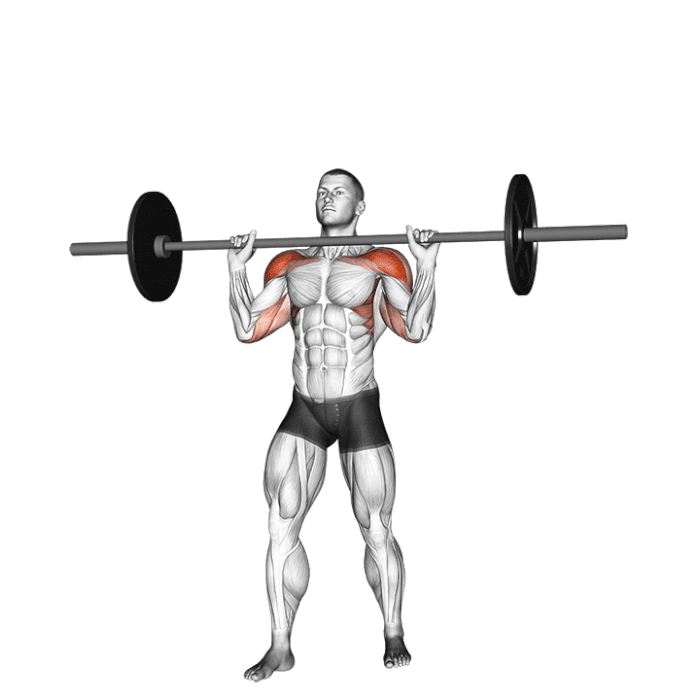Barbell Bench Press
The Barbell Bench Press is a classic compound exercise, widely regarded as one of the best upper-body strength movements. It is a fundamental part of strength training programs for beginners, athletes, and bodybuilders alike. The bench press primarily targets the chest, but it also engages several other muscle groups, making it an excellent choice for overall upper-body development. This exercise can be modified based on grip width and bench angle to target different areas of the chest.
It involves lying flat on a bench and pressing a barbell upwards from chest level. The movement engages the pectoral muscles as the prime movers, while the shoulders and triceps assist in the pressing motion. Since it’s a compound exercise, it requires strength, control, and coordination of multiple muscles, contributing to overall upper body development and pushing strength.
Targeted Muscle Groups

Primary Muscles:
- Pectoralis Major (Chest): The main muscle responsible for pressing the barbell upwards. It provides the power to move the weight and forms the majority of the chest mass.
Secondary Muscles:
- Anterior Deltoids (Shoulders): The front part of the shoulders helps in stabilizing and moving the barbell during the press.
- Triceps Brachii (Arms): The triceps extend the elbows as you press the barbell away from the chest.
- Serratus Anterior: This muscle helps to stabilize the shoulder blades during the press, enhancing shoulder stability.
- Core and Stabilizers: Although not directly targeted, the abs, obliques, and lower back muscles engage to maintain a stable posture on the bench.
Equipment Needed
- Barbell: The barbell is the key piece of equipment used in this exercise, and it typically weighs 20 kg (44 lbs) for an Olympic standard bar.
- Weight Plates: Plates are added to the barbell based on your strength level.
- Flat Bench: A stable bench that supports your back is essential.
- Safety Clips: Use safety clips to secure the plates on the barbell.
- Spotter (Optional): A spotter can assist you with heavier loads for safety.
How to Perform the Barbell Bench Press: Step-by-Step Guide
Step 1: Set Up the Bench
- Position the Bench: Set up a flat bench under a barbell rack. Ensure the bench is stable and centered beneath the bar.
- Load the Barbell: Add weight plates appropriate to your strength level and secure them with clips.

Muscles used in the military press.
Illustration credit © Aliaksandr Makatserchyk
Step 2: Lie Down and Get Into Position
- Lie Flat: Lie down on the bench with your back flat, and feet firmly on the ground. Your eyes should be directly under the bar.
- Grip the Barbell: Use a shoulder-width or slightly wider grip. Your hands should be evenly placed to ensure balance. For chest emphasis, use a standard grip where your thumbs wrap around the bar.
Step 3: Unrack the Barbell
- Lift the Bar: Engage your core, retract your shoulder blades, and press the barbell off the rack. Lock your elbows at the top.
- Hold at Starting Position: Move the barbell above your chest with your arms fully extended but not locked.
Step 4: Lower the Barbell
- Controlled Descent: Inhale deeply, and slowly lower the barbell to your chest. The bar should touch your mid-chest or just above the nipples.
- Maintain Elbow Angle: Keep your elbows at around a 45-degree angle from your torso to protect your shoulders.
Step 5: Press the Bar Upwards
- Push Through the Chest: Exhale as you press the barbell back up to the starting position. Focus on using your chest and triceps to push the bar.
- Lock at the Top: Fully extend your arms at the top of the movement, but avoid locking your elbows completely.
Step 6: Repeat and Rack
- Perform Reps: Continue for the desired number of repetitions.
- Re-rack the Bar: After completing your set, carefully guide the barbell back onto the rack with controlled movement.
Recommended Reps and Sets
- Beginners: 3 sets of 8-10 reps with light to moderate weight.
- Intermediate: 4 sets of 6-8 reps with moderate to heavy weight.
- Advanced: 4-5 sets of 4-6 reps with heavier weight to maximize strength gains.
Pro Tips for Success
- Focus on Form First: Start with light weights to perfect your form before adding more resistance. Proper form ensures safety and targets the correct muscle groups.
- Control the Movement: Lower the barbell slowly and with control to maximize muscle activation. Don’t let the bar drop quickly to your chest.
- Use a Spotter for Safety: A spotter is helpful when lifting heavier weights. They can assist if you struggle to lift the bar back up, reducing the risk of injury.
- Retract Shoulder Blades: Keep your shoulder blades retracted throughout the movement to protect your shoulders and stabilize the lift.
- Vary Your Grip: A wider grip emphasizes the chest more, while a narrower grip targets the triceps. Varying your grip can help target different muscle groups over time.
Common Mistakes to Avoid
- Arching the Lower Back: Overarching your lower back can lead to injury. Keep your back flat and press into the bench for proper form.
- Flaring Elbows Too Wide: Allowing your elbows to flare out too wide places unnecessary stress on the shoulder joints. Keep your elbows at a 45-degree angle from your torso to avoid strain.
- Bouncing the Bar off the Chest: Don’t use momentum by bouncing the bar off your chest. This reduces muscle engagement and increases injury risk.
- Partial Range of Motion: Ensure the barbell touches your chest during each rep. Partial reps limit muscle activation and reduce overall gains.
- Lifting the Feet: Keep your feet flat on the floor to maintain stability. Lifting your feet off the ground reduces your base of support, leading to a loss of balance.
The Barbell Bench Press is an essential upper-body exercise that offers significant benefits for strength and muscle development, particularly in the chest, shoulders, and triceps. By mastering proper form and consistently increasing the weight, you can build a powerful, well-rounded upper body. Remember to focus on controlled movements, engage a spotter when necessary, and avoid common mistakes like flaring elbows or bouncing the bar. Incorporate the bench press into your routine to enhance your upper-body strength and improve overall fitness.
